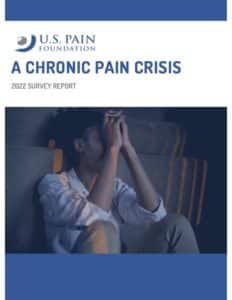
WEST HARTFORD, CONN., AUGUST 1, 2022 – The majority of people with chronic pain feel stigmatized by their medical providers. The finding is the result of a comprehensive survey report released today by the U.S. Pain Foundation. Among the report’s more disturbing findings was that people with pain often feel their health care providers are not equipped to manage their pain effectively. Over two-thirds (69%) either did not feel, or only “rarely” or “sometimes” felt, that their provider was on a team with them.
The organization surveyed 2,378 individuals to gather insight about individual experiences living with, caring for, or treating chronic pain. Nearly all respondents (96%) were people living with chronic pain, which is defined as pain lasting three months or more. Caregivers marked the second-largest group of respondents (3%), followed by health care professionals (1%). The bulk of the report focuses on the impact of chronic pain on those living with it.
“Chronic pain is vastly under-recognized, funded, and treated when considering its significant impact on American lives,” says U.S. Pain Foundation CEO Nicole Hemmenway.
Chronic pain in numbers
Nearly three-quarters (74%) of respondents had lived with pain for more than 10 years. While conditions varied widely, the most common pain conditions were primarily musculoskeletal in nature: back pain (67%), arthritis (56%), chronic low back pain (56%), nerve pain or neuropathy (53%), and neck pain (51%).
Over half (52%) said their average pain level is 7 or more on a scale of 1-10. 95% of respondents had at least one comorbidity, and almost all (99%) said pain has restricted their ability to engage in routine activities, like exercise, household chores, sleeping, and socializing. The majority (60%) said they feel anxiety-like symptoms daily or a few times a week, and a similar portion (59%) feel depression-like symptoms daily or a few times a week.
“Individuals are suffering, many times with multiple comorbidities, to the point of not being able to even shower or make a meal,” adds Hemmenway. “These enormous figures underscore the complexity of the health of this patient population.”
Treatments that help—and barriers to access
Multidisciplinary approaches were widely employed, with the top strategies including activity restriction or modification (73%), stress reduction techniques (42%), heat therapy (41%), and meditation and mindfulness (40%). In fact, activity restriction or modification is the most-used specific “therapy” of any kind across all categories, aside from prescription medications as an entire category.
When it comes to medications, a majority (77%) said prescription medications are the most helpful treatment in managing their pain. Roughly half of respondents take opioid medications (47%), although three-quarters of that group say they have faced significant barriers obtaining their medications. Nearly all (94%) of those taking opioids said they attribute these barriers to the 2016 CDC Guideline for Prescribing Opioids for Chronic Pain. A telling finding was that nearly a quarter (24%) said no side effect would prevent them from trying a medication to manage pain, underscoring the desperation for relief.
Cost remains the primary barrier to pain care. According to people with pain, the leading barrier to treatment was cost (49%), with nearly half (41%) of people with pain saying they felt insurance coverage decisions are driven by cost, not by what was in their best interest medically.
Change is desperately needed
In general, the data suggests not enough is being done for the management of chronic pain in America. Nearly half of respondents (41%), when asked about their top policy issues, reported wanting increased pain education for health care providers and new medications for chronic pain.
“Clearly, this report points to ample opportunities for all of us—patient groups, health care providers, insurers, and policymakers—to work together to better serve people with pain and improve pain care for millions of Americans,” says Hemmenway.
To learn more about the results and download the full report, visit uspainfoundation.org/surveyreports/a-chronic-pain-crisis.
###
About U.S. Pain Foundation
The mission of the U.S. Pain Foundation is to empower, educate, connect, and advocate for individuals living with chronic illness and serious injuries that cause pain, as well as their caregivers and clinicians. Its programs and services include a network of support groups, educational resources and events, a program for children and their families, federal advocacy efforts, a magazine called the INvisible Project, and more. The U.S. Pain Foundation is a 501(3)(c) nonprofit organization.
MEDIA INQUIRIES
Nicole Hemmenway
361-695-5382
nicole@uspainfoundation.org
